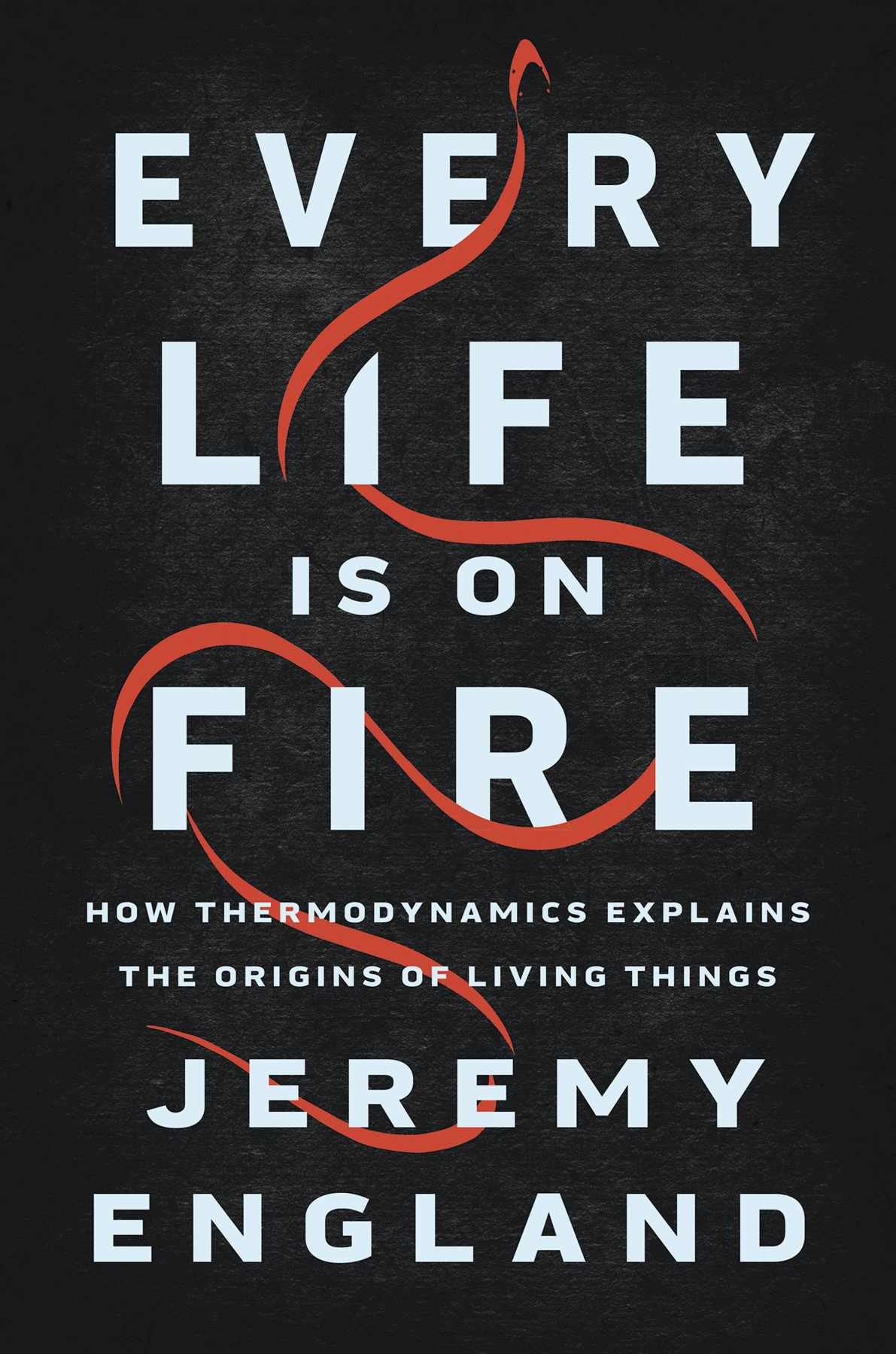Jeremy England - Every Life Is on Fire
Here you can read online Jeremy England - Every Life Is on Fire full text of the book (entire story) in english for free. Download pdf and epub, get meaning, cover and reviews about this ebook. year: 2020, publisher: Basic Books, genre: Romance novel. Description of the work, (preface) as well as reviews are available. Best literature library LitArk.com created for fans of good reading and offers a wide selection of genres:
Romance novel
Science fiction
Adventure
Detective
Science
History
Home and family
Prose
Art
Politics
Computer
Non-fiction
Religion
Business
Children
Humor
Choose a favorite category and find really read worthwhile books. Enjoy immersion in the world of imagination, feel the emotions of the characters or learn something new for yourself, make an fascinating discovery.

- Book:Every Life Is on Fire
- Author:
- Publisher:Basic Books
- Genre:
- Year:2020
- Rating:4 / 5
- Favourites:Add to favourites
- Your mark:
- 80
- 1
- 2
- 3
- 4
- 5
Every Life Is on Fire: summary, description and annotation
We offer to read an annotation, description, summary or preface (depends on what the author of the book "Every Life Is on Fire" wrote himself). If you haven't found the necessary information about the book — write in the comments, we will try to find it.
Every Life Is on Fire — read online for free the complete book (whole text) full work
Below is the text of the book, divided by pages. System saving the place of the last page read, allows you to conveniently read the book "Every Life Is on Fire" online for free, without having to search again every time where you left off. Put a bookmark, and you can go to the page where you finished reading at any time.
Font size:
Interval:
Bookmark:

Copyright 2020 by Jeremy England
Cover design by Ann Kirchner
Cover image Cover image Daboost / Shutterstock.com; illustration drawn from A snake, dark brown in colour. Watercolour, ca. 1795. Credit: Wellcome Collection. Attribution 4.0 International (CC BY 4.0)
Cover copyright 2020 Hachette Book Group, Inc.
Hachette Book Group supports the right to free expression and the value of copyright. The purpose of copyright is to encourage writers and artists to produce the creative works that enrich our culture.
The scanning, uploading, and distribution of this book without permission is a theft of the authors intellectual property. If you would like permission to use material from the book (other than for review purposes), please contact permissions@hbgusa.com. Thank you for your support of the authors rights.
Basic Books
Hachette Book Group
1290 Avenue of the Americas, New York, NY 10104
www.basicbooks.com
First Edition: September 2020
Published by Basic Books, an imprint of Perseus Books, LLC, a subsidiary of Hachette Book Group, Inc. The Basic Books name and logo is a trademark of the Hachette Book Group.
The Hachette Speakers Bureau provides a wide range of authors for speaking events. To find out more, go to www.hachettespeakersbureau.com or call (866) 376-6591.
The publisher is not responsible for websites (or their content) that are not owned by the publisher.
All art is courtesy of the author.
Library of Congress Cataloging-in-Publication Data
Names: England, Jeremy, author.
Title: Every life is on fire : how thermodynamics explains the origins of living things / Jeremy England.
Description: First edition. | New York : Basic Books, 2020. | Includes bibliographical references and index.
Identifiers: LCCN 2020003859 | ISBN 9781541699014 (hardcover) | ISBN 9781541699007 (ebook)
Subjects: LCSH: LifeOriginPopular works. | ThermodynamicsPopular works.
Classification: LCC QH325 .E64 2020 | DDC 576.8/3dc23
LC record available at https://lccn.loc.gov/2020003859
ISBNs: 978-1-5416-9901-4 (hardcover), 978-1-5416-9900-7 (ebook)
E3-20200820-JV-NF-ORI
 For my Miriam
For my Miriam
In the beginning, God created the heavens and the earth, and the earth was formless and void.
G ENESIS 1:12
T HE PUZZLE BREAKS DOWN AS FOLLOWS: EVERY LIVING THING we know of sprang from another living thing, yet we have reason to think that there was no life at all anywhere when the world first got going.world, and a great many other sorts of contemplative seekers struggling with the human condition may all agree on the importance of this question, yet much confusion and disagreement reigns about what kind of answer we are even looking for.
Some biophysicists might like to know which specific types of atoms collided with each other in order to form the first biomolecules, while others take for granted that something like this must have happened, and focus their inquiry instead on judging the likelihood of such an event under various conditions. For that matter, what even counts as life, and what doesnt? Was the early presence of life in the world a gray continuum through which things gradually progressed over time, or do we insist there must have been one moment when it burst decisively onto the scene? If the former, how precisely can we differentiate between something that is alive and something that isnt? If the latter, considering that life is good at doing an impressive number of things, which of them came into being first? Was it guaranteed to do so, in the same way that ice always melts in the warm sun, or must it have been sparked by a freak occurrence, one so rare that our best theory of how things transpired is no explanation at all? We understand something of why ice forms when water gets sufficiently cold, or why stars ignite when gravity is strong enough to squeeze hydrogen gas together, but it is strangely and marvelously more challenging to articulate the physical conditions in which nonliving matter is guaranteed to become alive. Like the skeptical onlooker at a magic show, many of us simply wont be satisfied until we get to see how the trick was done.
Tenacious scientific inquiry is not, however, the only reason people long so much to know something of how life began. A thoughtful human beingindeed, even a professional scientist willing to take an honest look in the mirror and examine his or her own sentiments carefullymay admit that the reason the question has such a command over us is that it expresses a shared yearning. The search for meaning and purpose begins with wondering where we came from and what we are part of, and seeking an account of how things began, partly because people use ideas about the past to decide how to act in the present and the future. If everything humans are made up of can be found in a pond or a chemistry set, then what really makes us different? Are humans simply animals, or something more? Does our existence express the intention of a Creator who made us in His image, or are weand all other lifemerely an exotic variety of frost condensed in the razor-thin layer between ground and sky? Can it be both? Once we start talking in these terms, the stakes of the argument could hardly be higher.
In this book, we will see that physical science does provide a new insight into when and how things that are not alive start to become more lifelike. Living things accomplish a variety of feats that, though not unique to life, are certainly distinctive of it. For example, they make copies of themselves, harvest and consume fuel, and accurately predict the surrounding environment. These processes are all part and parcel of what it is to be alive, and each of them can be studied systematically from the perspective of thermodynamics. Emphasizing recent progress in a rapidly growing offshoot of thermodynamics known as nonequilibrium statistical mechanics, this text will build up all the concepts needed to construct a clear argument for when and how the physical properties of inanimate matter might first give rise to the kinds of activities that life is particularly good at. The key point will be to realize that, just as living things have specialized properties determined by their genes that they have inherited from their ancestors, so, too, do collections of physically interacting particles have specialized properties that come from the past shapes into which theyve been assembled. By continually getting pushed and knocked around by patterns presented in the environment, matter can undergo a continual exploration of the space of possible shapes whose rhythm and form become matched to those patterns in ways that look an awful lot like living.
If all we aimed to do here were to make new physical sense of lifes distinctiveness, that would be plenty. And yet, even more so than most other scientific topics, this one surely demands a broader conversation. Whether because one needs to grapple mightily with the simple, definitional question of what is alive and what is not, or because arguments about the exceptionality, value, and purpose of life make up a large part of what people have disagreed and fought about throughout the ages, it seems thoroughly necessary to put our examination of the boundary between life and non-life in a suitably rich philosophical context. There might be more than one way of doing this well, in principle, but this is where my own deeply felt personal commitments come to bear. The way I know how to be most effective and accurate when talking about big questions of the human condition is to ground my understanding in interpretations of the Hebrew Bible. At the beginning of conceiving this book, I therefore set to pondering whether the Bible had anything cogent to say in reaction to the physics I planned to write about.
Font size:
Interval:
Bookmark:
Similar books «Every Life Is on Fire»
Look at similar books to Every Life Is on Fire. We have selected literature similar in name and meaning in the hope of providing readers with more options to find new, interesting, not yet read works.
Discussion, reviews of the book Every Life Is on Fire and just readers' own opinions. Leave your comments, write what you think about the work, its meaning or the main characters. Specify what exactly you liked and what you didn't like, and why you think so.











